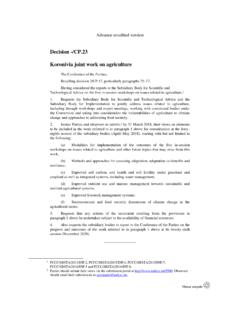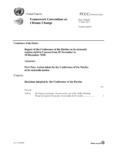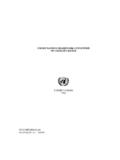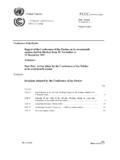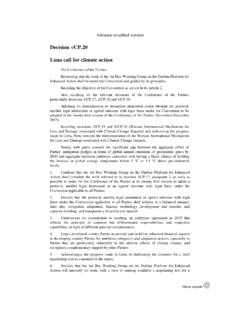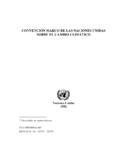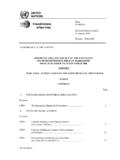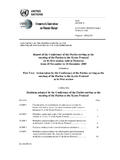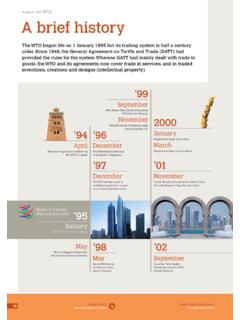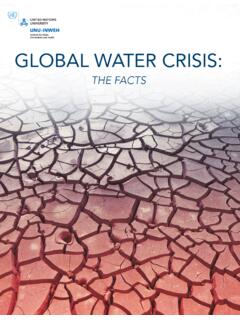Transcription of CLIMATE CHANGE: IMPACTS, VULNERABILITIES AND …
1 United Nations Framework Convention on CLIMATE ChangeUNFCCCCLIMATE CHANGE: IMPACTS, VULNERABILITIESAND ADAPTATIONIN DEVELOPING COUNTRIES1 CLIMATE change : IMPACTS, VULNERABILITIES AND ADAPTATION IN DEVELOPING COUNTRIESUNFCCCU nited Nations Framework Convention on CLIMATE change 3 UNFCCCCLIMATE change : IMPACTS, VULNERABILITIES AND ADAPTATION IN DEVELOPING COUNTRIESI. INTRODUCTION5II. CLIMATE change AND The need for Adaptation and the THE IMPACTS OF, AND VULNERABILITY AND ADAPTATION TO, CLIMATE Information gathering data, systematic observation and Information analysis reporting of impacts, vulnerability and adaptation15IV. REGIONAL IMPACTS OF AND VULNERABILITIES TO CLIMATE Latin Small island developing States24V. ADAPTATION TO CLIMATE Adaptation strategies, plans and Local coping Funding for Sustainable development planning and Adaptation integration into Capacity-building, education and training and public Education and Public Cooperation and Implementing adaptation49VI.
2 LOOKING FORWARD52 VII. REFERENCES55 TABLE OF CONTENTS5 UNFCCCCLIMATE change : IMPACTS, VULNERABILITIES AND ADAPTATION IN DEVELOPING COUNTRIESThe United Nations Framework Convention on ClimateChange (UNFCCC) secretariat has produced this book tohighlight the concerns and needs of developing countriesin adapting to the effects of CLIMATE change . This bookoutlines the impact of CLIMATE change in four developingcountry regions: Africa, Asia, Latin America and small island developing States; the vulnerability of these regions to future CLIMATE change ; current adaptation plans, strategies and actions; and future adaptation options and book draws heavily on information provided by Parties to the UNFCCC, particularly that provided at threeregional workshops held in Africa, Asia and Latin Americaand one expert meeting held in small island developingStates during 2006 20071, as mandated by the BuenosAires programme of work on adaptation and responsemeasures (decision 1 of the Conference of the Parties to the UNFCCC)2, as well as information in national communications3and national adaptation programmes of action4submitted to the UNFCCC, reports from the Intergovernmental Panel on CLIMATE change (IPCC 2007)
3 And other sources, as the next decades, it is predicted that billions of people, particularly those in developing countries, faceshortages of water and food and greater risks to health and life as a result of CLIMATE change Concerted global action is needed to enable developing countries to adapt to the effects of CLIMATE change that are happeningnow and will worsen in the future. The urgency for adaptation is highlighted by projectionsfrom the three reports produced by the IPCC in 2007 (IPCC 2007). Under a business as usual scenario, greenhousegas emissions could rise by 25 90 per cent by 2030 relative to 2000 and the Earth could warm by 3 C this century. Even with a temperature rise of 1 C the IPCC predict serious effects including reduced crop yieldsin tropical areas leading to increased risk of hunger,spread of CLIMATE sensitive diseases such as malaria, andan increased risk of extinction of 20 30 per cent of allplant and animal species.
4 By 2020, up to 250 million people in Africa could be exposed to greater risk of waterstress. Over the course of this century, millions of peopleliving in the catchment areas of the Himalayas and Andesface increased risk of floods as glaciers retreat followed bydrought and water scarcity as the once extensive glacierson these mountain ranges disappear. Sea level rise willlead to inundation of coasts worldwide with some small island States possibly facing complete inundation and people living with the constant threat of tropical cyclonesnow face increased severity and possibly increased frequency of these events with all associated risks to lifeand UNFCCC secretariat, using current information available on existing and projected investment flows andfinancing relevant to the development of an effective and appropriate international response to CLIMATE change ,has estimated that by 2030 developing countries will require USD 28 67 billion in funds to enable adaptationto CLIMATE corresponds to per cent of global investment flows, or just per cent ofprojected global GDP, in 2030.
5 Current global funding for adaptation is a fraction of this figure and access tothese funds for developing countries is often lengthy and countries are the most vulnerable to climatechange impacts because they have fewer resources toadapt: socially, technologically and financially. Climatechange is anticipated to have far reaching effects on thesustainable development of developing countries includingtheir ability to attain the United Nations Millennium development Goals by 2015 (UN 2007). Many developingcountries governments have given adaptation action ahigh, even urgent, priority. I. INTRODUCTION1< >2< #page=2>3< >4< >5< >INTRODUCTION6 UNFCCCCLIMATE change : IMPACTS, VULNERABILITIES AND ADAPTATION IN DEVELOPING COUNTRIESD eveloping countries need international assistance to support adaptation in the context of national planning for sustainable development , more capacity-building andtransfer of technology and funds.
6 Systematic planningand capacity-building are also needed to reduce the risk of disasters and raise the resilience of communities to increasing extreme events such as droughts, floods andtropical cyclones. Funding for adaptation in developingcountries must be sufficient and sustained. Least developedcountries (LDCs) and small island developing States (SIDS) in particular need special consideration due to their extreme vulnerability. In this book, background information on CLIMATE changeand why adaptation is needed in developing countries is provided in chapter II. The chapter also explains how theUNFCCC, which provides the basis for international action on CLIMATE change , is helping adaptation efforts in developing large amount of work has already been carried out bymany countries on assessing impacts and VULNERABILITIES to CLIMATE change , as well as considering possible adaptationoptions.
7 Chapter IIIcovers how assessments on climatechange are made by countries, including the gaps and needsof developing countries in information collection andanalysis. Although there is still much work to be done, itwas emphasised at all the UNFCCC-organized workshopsand expert meeting that this should not be an obstacle toprogress being made on implementing countries have very different individual circumstances and the specific impacts of CLIMATE changeon a country depend on the CLIMATE it experiences as well as its geographical, social, cultural, economic and political situations. As a result, countries require a diversity of adaptation measures very much depending on individual circumstances. However there are cross cutting issues which apply across countries and same sectors are affected by CLIMATE change , albeit to differing degrees.
8 These main sectors include: agriculture ,water resources, human health, terrestrial ecosystems and biodiversity and coastal zones. Chapter IVlooks at thecurrent and future impacts and VULNERABILITIES across these sectors in developing knowledge of how best to do adaptation is stillin its infancy, the Parties of the UNFCCC are increasingtheir support for action on adaptation. This includes thedevelopment of national adaptation programmes by somedeveloping countries including least developed countries,and their integration into national strategies. Climatechange solutions need to identify and exploit synergy, aswell as seek to balance trade-offs, among the multiple objectives of sustainable development , disaster risk reductionand adaptation policies. Such initiatives also require newand sustained funding sources.
9 Chapter Vhighlights theadaptation needs and responses of developing countries to CLIMATE change and how the work of the UNFCCC canhelp catalyse more work on adaptation in these chapter also highlights the need to plan and implementadaptation in the context of sustainable development and integrate adaptation into policy at all levels. Recommendations from the workshops and meeting onhow to cross the gap between planning and implementingadaptation options are highlighted. Finally, chapter VIlooks forward to give an indication of possible next steps for the UNFCCC, including within a future CLIMATE regime beyond 2012, in addressing adaptation options for the threats posed by CLIMATE change : IMPACTS, VULNERABILITIES AND ADAPTATION IN DEVELOPING COUNTRIESR ising fossil fuel burning and land use changes haveemitted, and are continuing to emit, increasing quantitiesof greenhouse gases into the Earth s atmosphere.
10 Thesegreenhouse gases include carbon dioxide (CO2), methane(CH4) and nitrogen dioxide (N2O), and a rise in these gases has caused a rise in the amount of heat from thesun withheld in the Earth s atmosphere, heat that would normally be radiated back into space. This increase in heathas led to the greenhouse effect, resulting in CLIMATE change . The main characteristics of CLIMATE change are increases in average global temperature (global warming);changes in cloud cover and precipitation particularly overland; melting of ice caps and glaciers and reduced snowcover; and increases in ocean temperatures and oceanacidity due to seawater absorbing heat and carbon dioxide from the atmosphere (Figure II-1). The Fourth Assessment Report of the IntergovernmentalPanel on CLIMATE change (IPCC 2007) dispelled many uncertainties about CLIMATE change .
